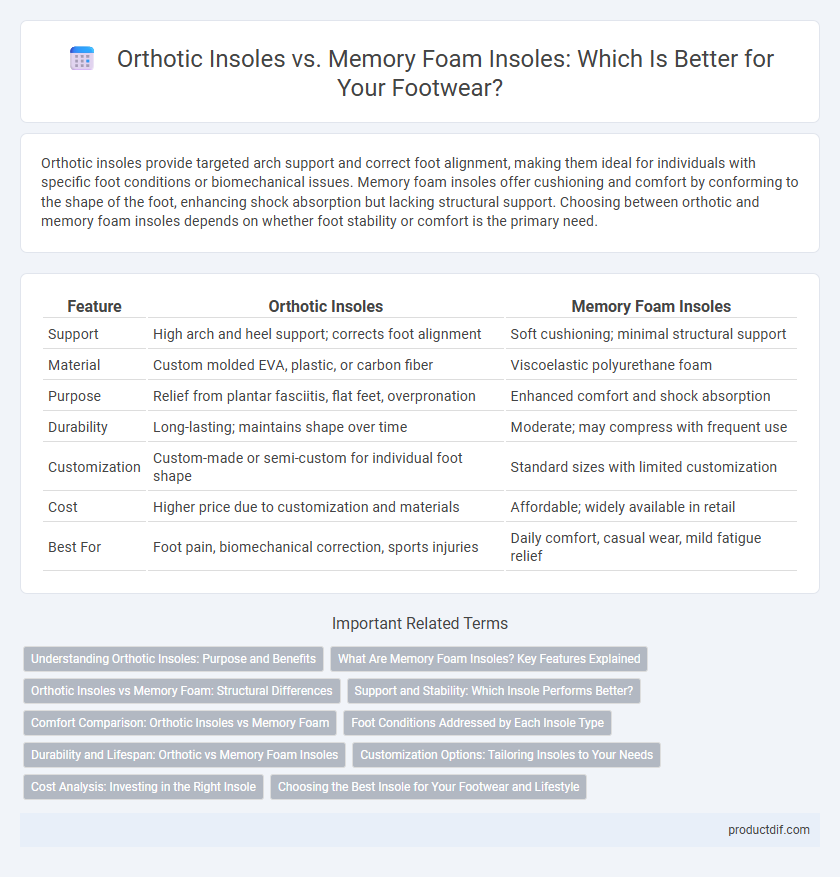Orthotic insoles provide targeted arch support and correct foot alignment, making them ideal for individuals with specific foot conditions or biomechanical issues. Memory foam insoles offer cushioning and comfort by conforming to the shape of the foot, enhancing shock absorption but lacking structural support. Choosing between orthotic and memory foam insoles depends on whether foot stability or comfort is the primary need.
Table of Comparison
| Feature | Orthotic Insoles | Memory Foam Insoles |
|---|---|---|
| Support | High arch and heel support; corrects foot alignment | Soft cushioning; minimal structural support |
| Material | Custom molded EVA, plastic, or carbon fiber | Viscoelastic polyurethane foam |
| Purpose | Relief from plantar fasciitis, flat feet, overpronation | Enhanced comfort and shock absorption |
| Durability | Long-lasting; maintains shape over time | Moderate; may compress with frequent use |
| Customization | Custom-made or semi-custom for individual foot shape | Standard sizes with limited customization |
| Cost | Higher price due to customization and materials | Affordable; widely available in retail |
| Best For | Foot pain, biomechanical correction, sports injuries | Daily comfort, casual wear, mild fatigue relief |
Understanding Orthotic Insoles: Purpose and Benefits
Orthotic insoles are specifically designed to support the foot's natural structure, alleviate pain from conditions like plantar fasciitis, flat feet, or overpronation, and improve overall foot alignment. Unlike memory foam insoles, which prioritize cushioning and comfort, orthotic insoles provide targeted support to correct biomechanical issues and reduce strain on muscles, tendons, and joints. Utilizing custom-molded orthotic insoles can enhance stability, prevent injury, and address chronic foot problems more effectively than generic foam alternatives.
What Are Memory Foam Insoles? Key Features Explained
Memory foam insoles are designed with viscoelastic polyurethane foam that molds to the shape of the foot, providing customized cushioning and pressure relief. Key features include excellent shock absorption, enhanced comfort for prolonged standing or walking, and improved support for arch and heel alignment. These insoles are ideal for individuals seeking softer padding and adaptive fit in everyday footwear.
Orthotic Insoles vs Memory Foam: Structural Differences
Orthotic insoles feature rigid or semi-rigid supports designed to correct foot alignment and provide targeted arch support, addressing specific biomechanical issues. Memory foam insoles consist of soft, cushioning materials that conform to the foot's shape for enhanced comfort but lack structured support. The primary structural difference lies in orthotics being engineered for corrective purposes, while memory foam prioritizes shock absorption and pressure distribution.
Support and Stability: Which Insole Performs Better?
Orthotic insoles provide superior support and stability by offering custom arch support and correcting foot alignment, which helps alleviate pain and prevent injuries. Memory foam insoles excel in cushioning and comfort but lack the structural support needed for long-term stability and biomechanical correction. For individuals requiring enhanced foot support and stability, orthotic insoles are generally the better-performing option.
Comfort Comparison: Orthotic Insoles vs Memory Foam
Orthotic insoles provide targeted support by aligning the foot's structure, reducing pain and improving stability, especially for those with specific biomechanical issues. Memory foam insoles offer a soft, cushioning feel that molds to the foot's shape, enhancing comfort during prolonged wear but lacking structural support. Comparing comfort, orthotic insoles excel in corrective benefits and long-term relief, while memory foam insoles deliver immediate plush comfort ideal for everyday casual use.
Foot Conditions Addressed by Each Insole Type
Orthotic insoles specifically target foot conditions such as plantar fasciitis, flat feet, and overpronation by providing customized arch support and realignment. Memory foam insoles primarily enhance comfort and absorb shock, helping to reduce general foot fatigue and minor pressure points but lack the structural correction needed for serious biomechanical issues. Choosing the right insole depends on whether the priority is therapeutic correction or cushioning for daily comfort.
Durability and Lifespan: Orthotic vs Memory Foam Insoles
Orthotic insoles typically offer superior durability and a longer lifespan, often lasting up to 12 months with consistent use, due to their rigid support materials designed to maintain structural integrity. Memory foam insoles, while providing immediate comfort and cushioning, tend to compress and lose their shape within 3 to 6 months, reducing their effectiveness over time. Choosing orthotic insoles ensures sustained foot alignment and support, making them a more durable option for long-term foot health.
Customization Options: Tailoring Insoles to Your Needs
Orthotic insoles offer precise customization by addressing specific foot conditions such as plantar fasciitis, flat feet, and overpronation through molded designs based on individual foot scans. Memory foam insoles provide moderate adaptation by conforming to the foot's shape for enhanced comfort but lack targeted support for biomechanical issues. Choosing between these insoles depends on the need for personalized corrective support versus general cushioning tailored to everyday comfort.
Cost Analysis: Investing in the Right Insole
Orthotic insoles typically range from $100 to $300 due to custom fitting and specialized materials, offering targeted support and long-term foot health benefits. Memory foam insoles are generally priced between $10 and $50, providing basic cushioning but lacking structural correction. Investing in orthotic insoles can result in reduced medical expenses related to foot pain and injury, making them cost-effective despite higher initial costs.
Choosing the Best Insole for Your Footwear and Lifestyle
Orthotic insoles provide targeted arch support and correct biomechanical imbalances, making them ideal for individuals with specific foot conditions such as plantar fasciitis or flat feet. Memory foam insoles offer superior cushioning and pressure distribution, enhancing comfort for everyday activities and reducing foot fatigue. Selecting the best insole depends on your footwear type, activity level, and whether you need support for structural issues or enhanced cushioning for all-day comfort.
Orthotic insoles vs memory foam insoles Infographic

 productdif.com
productdif.com